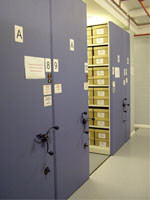Guidance for storage of archives
The causes of deterioration of archives and guidance for storage
 Materials within archive collections are largely organic and can be as varied as the collections themselves. It is the diversity of materials and their special needs that require specialised storage and preservation solutions and it is their fragility that can lead to physical damage if these solutions are not provided.
Materials within archive collections are largely organic and can be as varied as the collections themselves. It is the diversity of materials and their special needs that require specialised storage and preservation solutions and it is their fragility that can lead to physical damage if these solutions are not provided.
Materials may include:
- paper
- parchment
- photographic supports and emulsions
- book structures and associated covering materials such as leather, cloth and parchment
Causes of damage
Most damage is caused by a combination of factors. These may include:
- damp
- mould
- insects
- unsuitable packaging
- frequent or careless handling
Light damage
All materials are damaged by light, particularly ultra violet light.
- Low-grade papers such as newspapers and posters degrade quickly and become brittle particularly if exposed to heat and light.
- Photographs can be on a support of glass, plastic, paper or metal, which all require special care. Their emulsions are very absorbent and delicate and must be handled with extreme caution.
Environment
For the safe storage of infrequently handled archives a constant temperature within the range of 16 - 19º C with a tolerance of 1ºC either side and relative humidity (RH) of between 45-60% with a tolerance of 5% either side is recommended. RH is a measure of how damp or dry the air is.
In practical terms this means finding a cool dry place. In most homes particularly modern houses, a cool dry place will mean a bedroom, spare room or dining room which has only background heating most of the time. Cellars are almost always damp and roof spaces will be subject to extremes of temperature and humidity according to the season.
High or low RH and temperature are damaging in many ways. High RH and temperature will support the growth of mould, microbiological activity and the development of acidity. Conversely, low RH will result in the drying out and embrittlement of the cellulose fibres within paper.
Constancy in storage conditions is essential as fluctuations in temperature and RH are damaging to materials. The goal is to maintain a stable and consistent environment and to avoid extremes.
All items should be kept out of direct sunlight. If items must be displayed then ultra violet filters will help to reduce damage; these can be fitted to windows and lights. Curtains and blinds will also help to reduce exposure.
Archival storage materials
Archival storage materials provide support for fragile items and protection against light, dust, careless handling and damage during transport.
All material in contact with an original item should be of archival quality and acid-free. These materials are often described as either:
- archival quality
- conservation quality
- acid free
It is important to remember that products will not be of archival quality unless specifically stated. Approved suppliers will always supply details of their products' chemical and physical properties.